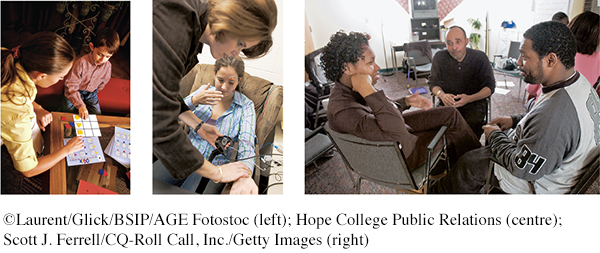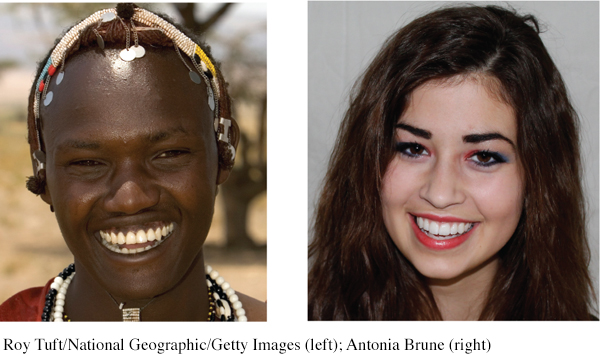1.2 Four Big Ideas in Psychology
LOQ 1-
Woven throughout this book are four of psychology’s big ideas.
Critical thinking The scientific attitude prepares us to think smarter—
to examine assumptions, consider the source, uncover hidden values, weigh evidence, and test conclusions. Science- aided thinking is smart thinking. The biopsychosocial approach We can view human behavior from three levels—
the biological, psychological, and social- cultural. We share a biologically rooted human nature. Yet cultural and psychological influences fine- tune our assumptions, values, and behaviors. The two-
track mind Today’s psychological science explores our dual-processing capacity. Our perception, thinking, memory, and attitudes all operate on two levels: a conscious, aware track, and an unconscious, automatic, unaware track. It has been a surprise to learn how much information processing happens without our awareness.Exploring human strengths Psychology today focuses not only on understanding and offering relief from troublesome behaviors and emotions, but also on understanding and developing the emotions and traits that help us to thrive.
Let’s consider these four ideas, one by one.

Big Idea 1: Critical Thinking Is Smart Thinking
critical thinking thinking that does not blindly accept arguments and conclusions. Rather, it examines assumptions, uncovers hidden values, weighs evidence, and assesses conclusions.
Whether reading an online article or swapping ideas with others, critical thinkers ask questions. How do they know that? Who benefits from this? Is the conclusion based on a personal story and gut feelings, or on evidence? How do we know one event caused the other? How else could we explain things?
From a Twitter feed:
“The problem with quotes on the Internet is that you never know if they’re true.”
Abraham Lincoln
In psychology, critical thinking has led to some surprising findings. Believe it or not . . .
massive losses of brain tissue early in life may have few long-
term effects (see Chapter 2). within days, newborns can recognize their mother’s odor (Chapter 3).
after brain damage, some people can learn new skills, yet at the mind’s conscious level be unaware that they have these skills (Chapter 7).
most of us—
male and female, old and young, wealthy and not wealthy, with and without disabilities— report roughly the same levels of personal happiness (Chapter 10). an electric shock delivered to the brain (electroconvulsive therapy) may relieve severe depression when all else has failed (Chapter 14).
This same critical thinking has also debunked some popular beliefs. When we let the evidence speak for itself, we learn that . . .
sleepwalkers are not acting out their dreams (Chapter 2).
our past experiences are not recorded word for word in our brain. Neither brain stimulation nor hypnosis will let us “hit the replay button” and relive long-
buried memories (Chapter 7). most of us do not suffer from low self-
esteem, and high self- esteem is not all good (Chapter 12). opposites do not generally attract (Chapter 11).
In later chapters, you’ll see many more examples in which psychology’s critical thinking has challenged old beliefs and led us onto new paths.
Big Idea 2: Behavior Is a Biopsychosocial Event
Each of us is part of a larger social system—
biopsychosocial approach an approach that integrates different but complementary views from biological, psychological, and social-
If we study this complexity with simple tools, we may end up with partial answers. Consider the many ways of explaining horrific school shootings. Is it because the shooters have brain disorders or genetic tendencies that cause them to be violent? Because they have observed brutality and mayhem in the media or played violent video games? Because they live in a gun-

culture the enduring behaviors, ideas, attitudes, values, and traditions shared by a group of people and handed down from one generation to the next.
Suppose we wanted to study gender differences in a group of people. Gender is not the same as sex. Gender refers to the traits and behaviors we expect from a boy or girl, or a man or woman in a specific culture. Sex refers to the biological characteristics people inherit, thanks to their genes. To study gender similarities and differences, we would want to know about biological influences. But we would also want to understand how the group’s culture—the shared ideas and behaviors that one generation passes on to the next—

Even with this much information about people’s gender and culture, our view would be incomplete. We would also need some understanding of how the individuals in a group differ from one another because of their personal abilities and learning.

Studying all these influences in various people around the world, researchers have found some gender differences—
nature–
Psychologists have used the biopsychosocial approach to study many of the field’s big questions. One of the biggest and most persistent is the nature–
How are intelligence and personality differences influenced by heredity and by environment?
Is our sexual orientation written in our genes or learned through our experiences?
Page 10Can life experiences affect the expression of our genes?
Should we treat depression as a disorder of the brain or a disorder of thought—
or both?
In most cases, nurture works on what nature provides. Our species has been graced with a great biological gift: an enormous ability to learn and adapt. Moreover (and you will read this over and over in the pages that follow), every psychological event—
Big Idea 3: We Operate With a Two-Track Mind (Dual Processing)
dual processing the principle that our mind processes information at the same time on separate conscious and unconscious tracks.
Mountains of new research reveal that our brain works on two tracks. Our conscious mind feels like our body’s chief executive, and in fact we do process much information on our brain’s conscious track, with full awareness. But at the same time, a surprisingly large unconscious, automatic track is processing information outside of our awareness. Thinking, memory, perception, language, and attitudes all operate on these two tracks. Today’s researchers call it dual processing. We know more than we know we know.
Vision is a great example of our dual processing. As science often reveals, truth can be stranger than fiction.
During a stay at Scotland’s University of St. Andrews, I [DM] came to know research psychologists Melvyn Goodale and David Milner (2004, 2006). A local woman, whom they studied and call D. F., was overcome by carbon monoxide one day. The resulting brain damage left her unable to consciously perceive objects. Yet she acted as if she could see them. Slip a postcard into a mail slot? She could do so without error. Report the width of a block in front of her? No, but she could grasp it with just the right finger-
The eye sends information to different brain areas, and each of these areas has a different task. A scan of D. F.’s brain revealed normal activity in an area concerned with reaching for and grasping objects, but not in another area concerned with consciously recognizing objects. A few other patients have a reverse pattern of damage. As you might expect, their symptoms are the reverse of D. F.’s. They can see and recognize objects, but they have difficulty pointing toward or grasping them.
We think of our vision as one system: We look. We see. We respond to what we see. Actually, vision is a two-
This big idea—
Big Idea 4: Psychology Explores Human Strengths as Well as Challenges
positive psychology the scientific study of human functioning, with the goals of discovering and promoting strengths and virtues that help individuals and communities to thrive.
Psychology’s first hundred years focused on understanding and treating troubles, such as abuse and anxiety, depression and disease, prejudice and poverty. Much of today’s psychology continues the exploration of such challenges. Without slighting the need to repair damage and cure disease, Martin Seligman and others (2002, 2005, 2011) have called for more research on human flourishing. These psychologists call their approach positive psychology. They believe that happiness is a by-
positive emotions, such as satisfaction with the past, happiness with the present, and optimism about the future.
positive character traits, such as creativity, courage, compassion, integrity, self-
control, leadership, wisdom, and spirituality. Current research examines the roots and fruits of such qualities, sometimes by studying the lives of individuals who offer striking examples. positive institutions, such as healthy families, supportive neighborhoods, effective schools, and socially responsible media.
Will psychology have a more positive mission in this century? Can it help us all to flourish? An increasing number of scientists worldwide believe it can.